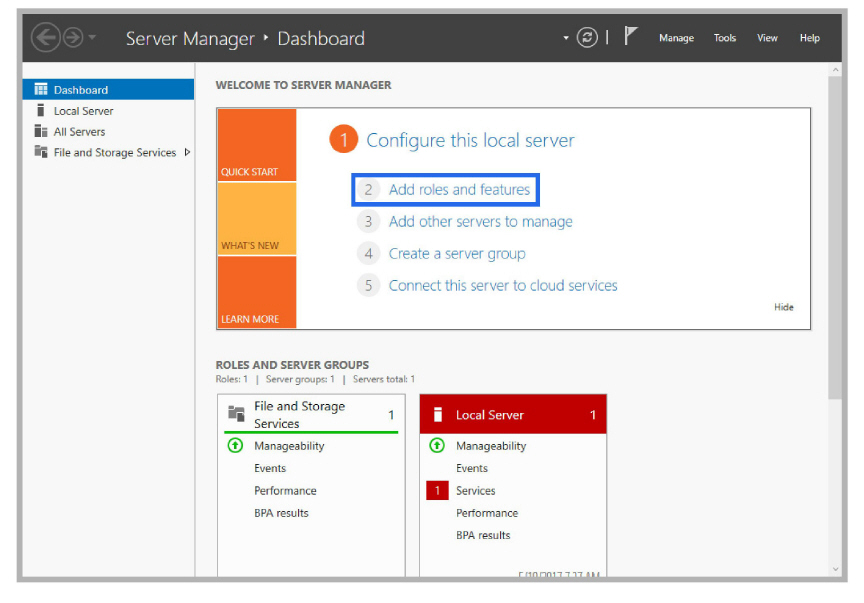
Windows Server 2016 Installation (SIP)
When installing Avaya Messaging version 10.8, almost all choices regarding program configuration are asked at the beginning so that the many components can be installed without interruption. The only variation that occurs after the initial selection is the PBX and integration type, which will be unique to most sites.
|
Warning: The instructions found in this guide cannot be guaranteed to work for all installations since each site is unique. Some problems may arise even if you follow these instructions precisely. Therefore, use this document as a reference for your own configuration, making the changes appropriate to your site's specific requirements. |
|
Requirements |
Details |
|
License |
A Full License for 10.8. |
|
Software |
For details on Avaya Messaging 10.8 Hardware and Software requirements please consult the Technical Operating Guidelines. |
|
Important: Microsoft Windows is not provided with any version of Avaya Messaging. The customer must install and fully update a suitable, licensed version of Windows onto the hardware platform before proceeding with the Avaya Messaging software installation. |
|
Note: Avaya Messaging has only been validated on Windows in English and in French. Other varieties of Windows may not work as intended. |
|
Note: Avaya Messaging should only be installed on a dedicated server specifically intended for the purpose. Sharing system resources with other applications may prevent Avaya Messaging from functioning properly. |
|
Caution: It is strongly recommended that, for Windows Server 2016, the operating system drive has a minimum of 100GB reserved exclusively for the O/S. This is in addition to any amount required for the Avaya Messaging voice server installation. |
Avaya Messaging can be downloaded from the Avaya PLDS portal. The same downloaded file can be used to install any version of the program including Single Server, High Availability (Primary, Secondary, Consolidated), Cloud Gateway, etc.
Download and save the file to a computer hard drive. It is a single, self-extracting executable file. Copy the file to the destination computer(s) and double-click to extract all of the installation files to the local hard drive.
Run the Setup.exe file to launch the installer.
Continue with the chapter appropriate for your operating system (i.e. Windows 2016) or feature set (i.e. JITC).
Deployment Configuration Considerations
•An Avaya Messaging server may be installed on the root drive (the same drive where Windows is installed). This must be a local drive. iSCSI targets are not supported.
•An Avaya Messaging server may be installed on a secondary drive (on a different drive from where Windows is installed). This must be a local drive. iSCSI targets are not supported.
•The drives may each be a physical drive (for best performance), or a single drive with partitions.
•The folders \uc\logs, \uc\DB, and \uc\messages may be mounted to a local drive. Network or mapped drives are not supported.
•In an ESX(i)/VMWare environment, SAN/iSCSI is supported, but only at the ESX(i) level. The iSCSI target must be mounted and managed by the ESX(i) host. If a virtual machine is to have a C drive and a D drive, they must be added as a virtual hard disk using the VMWare client.
•The rules for drive types and options are the same for virtual machine environments. The storage must be local, Direct Attached Storage or SAN.
|
Warning: These configurations have been tested and approved by Avaya for use with Avaya Messaging. While other configurations may be possible, Avaya cannot provide support in these areas. |
It is suggested that any antivirus applications currently active on the server computer be disabled during installation. Any other resource intensive applications or monitoring tools which may cause a conflict with the installation should also be disabled during the installation process.
For Microsoft Windows Server 2016, you must ensure that all the necessary server roles and features are installed on the system before proceeding with Avaya Messaging installation.
Avaya Messaging requires that signed digital certificates be installed on the voice server before attempting an installation.
Certificates are used to create secure connections between the voice server and the client. The client uses the certificate to authenticate the signature stored on the server while negotiating a secure connection.
Digital certificates can be purchased from any trusted Certificate Authority (CA), such as GoDaddy™ and Symantec™. It is also possible to create a self-signed certificate for use with the program.
1.From the Server Manager Dashboard, click Add roles and features.

If this screen is hidden, go to View and select Show Welcome Tile.
2.Click Next.
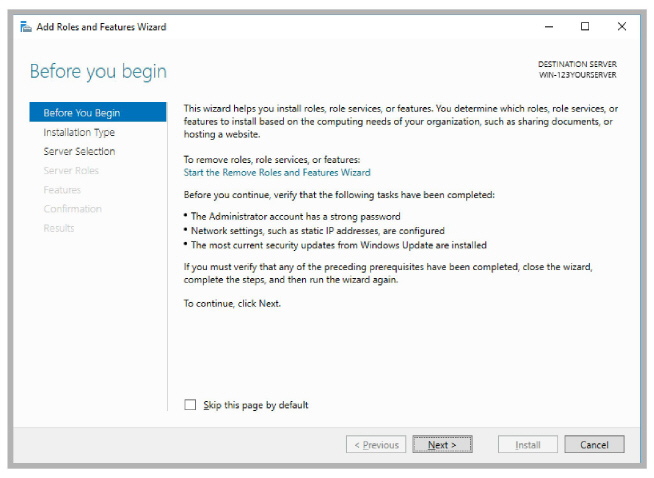
3.Leave the default settings as they are. Click Next.
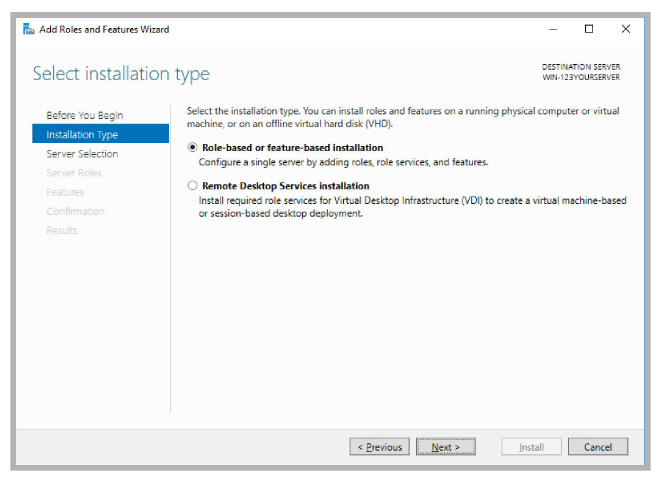
4.Leave the default settings as they are. Click Next.
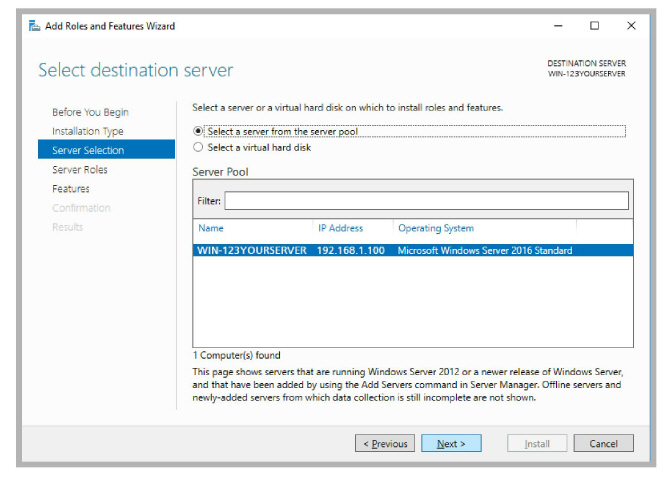
5.Enable Fax Server. When prompted, select Add Features.
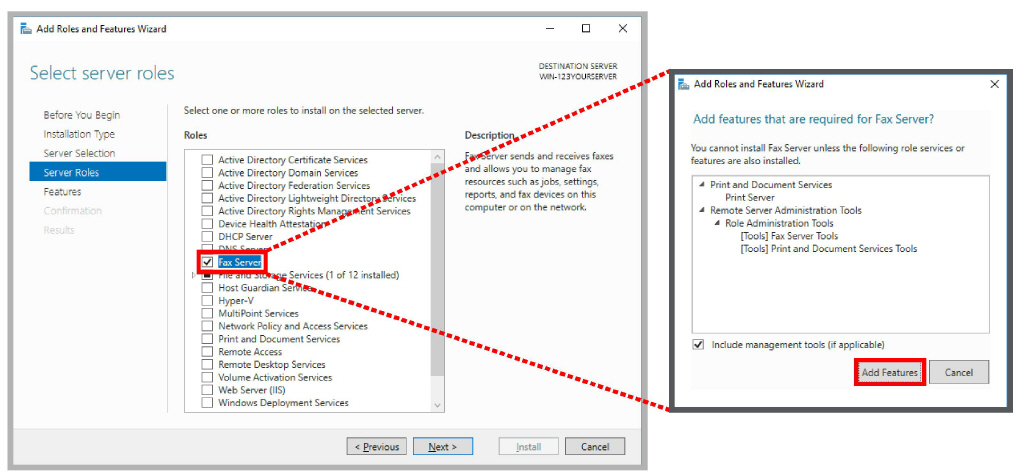
6.Enable Web Server (IIS). When prompted, select Add Features. Click Next.
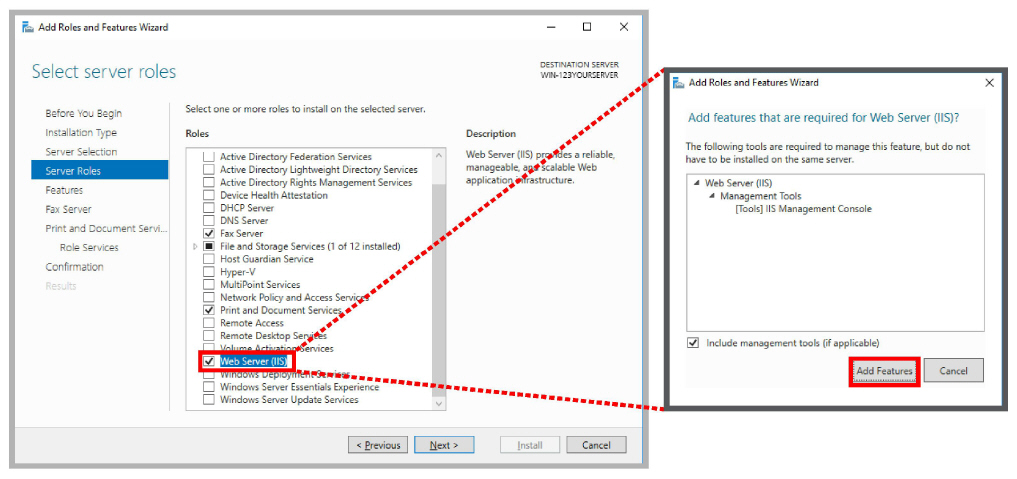
7.On the Features panel, open .NET Framework 3.5 Features and enable HTTP Activation. When prompted, select Add Features. Click Next.
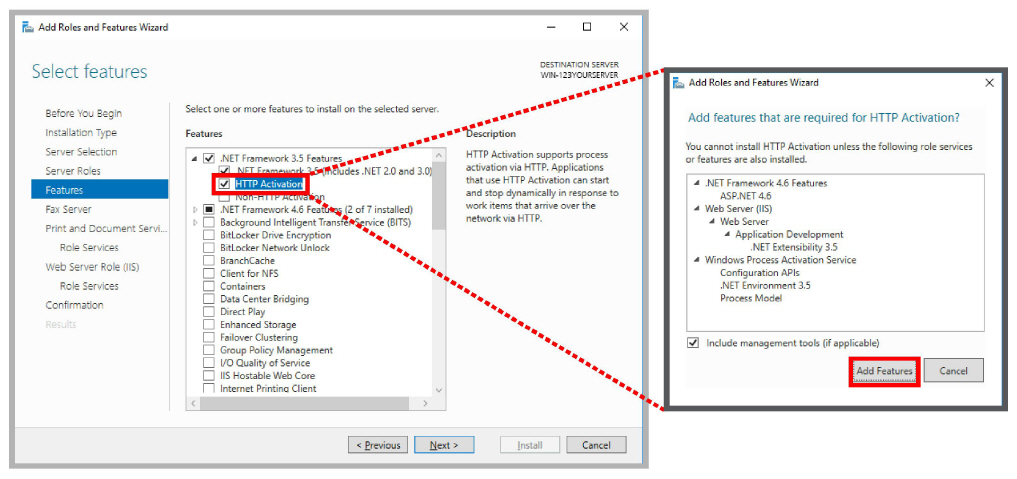
8.Optional: If you plan to use SNMP Alarms with Avaya Messaging, the SNMP Service must be added to Windows before the program can be installed.
If SNMP Alarms are required, scroll down and enable SNMP Service.
If SNMP Alarms are not required, skip this step.
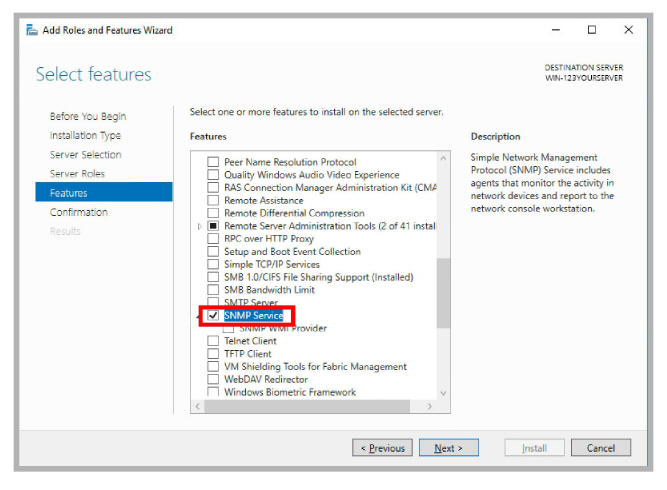
9.On the Fax Server screen, click Next.
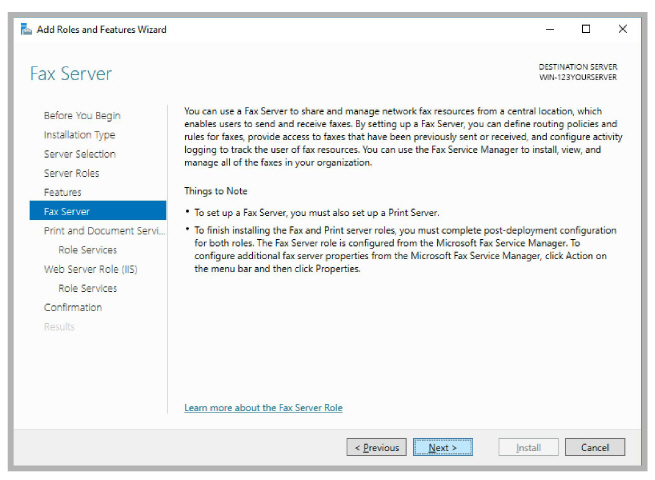
10.On the Print and Document Services screen, click Next.
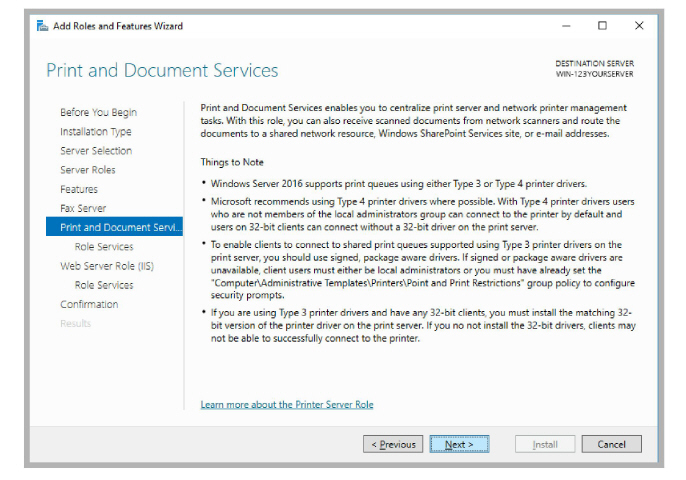
11.No changes are required here. Click Next.
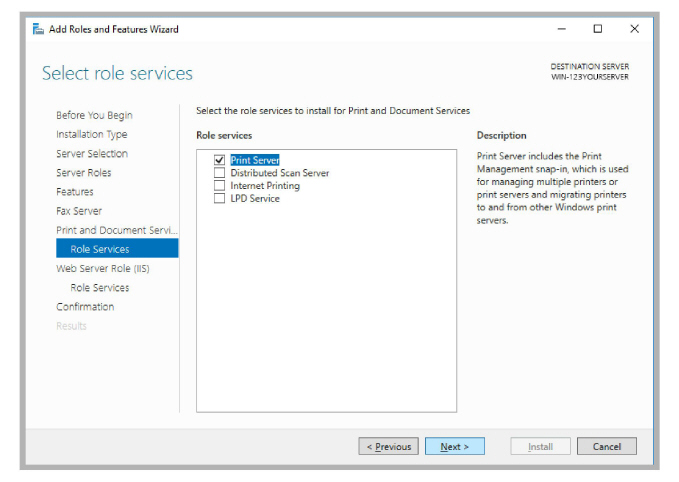
12.On the Web Server Role (IIS) screen, click Next.
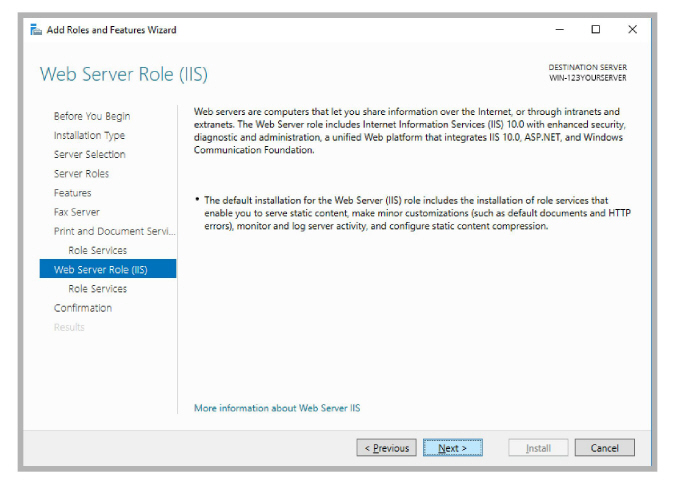
13.Under Web Server > Common HTTP Features, enable HTTP Redirection.
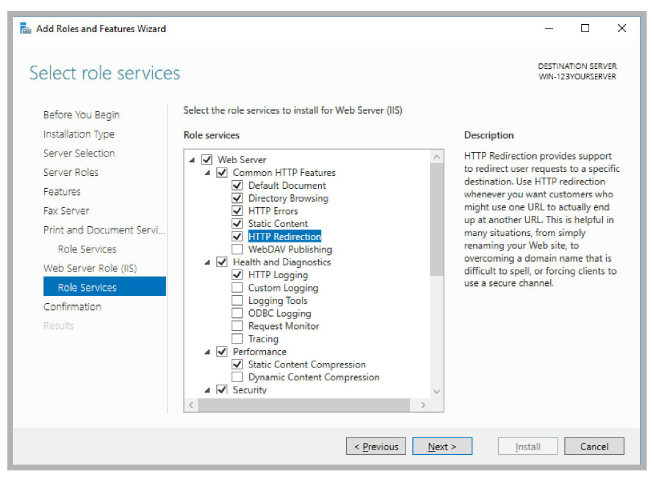
14.Under Web Server > Security, enable Windows Authentication.
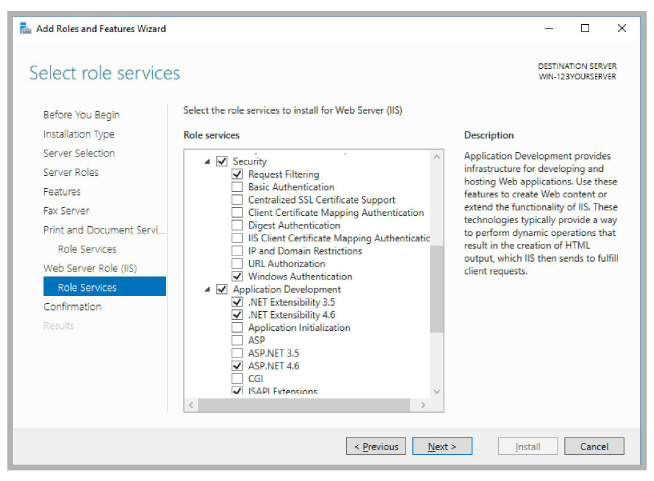
15.Under Web Server > Application Development, enable .NET Extensibility 3.5, .NET Extensibility 4.6, ASP, ASP .NET 3.5, ASP .NET 4.6, CGI, ISAPI Extensions, ISAPI Filters and WebSocket Protocol.
Under FTP Server, enable FTP Service.
When ready, click Next.
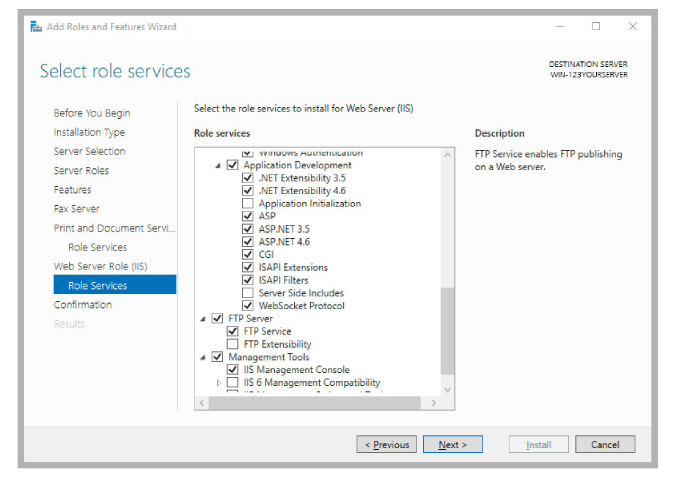
16.Review the selections here. When ready to proceed, click Install.

17.Windows will now start the installation process for the chosen items. This process may take a while.
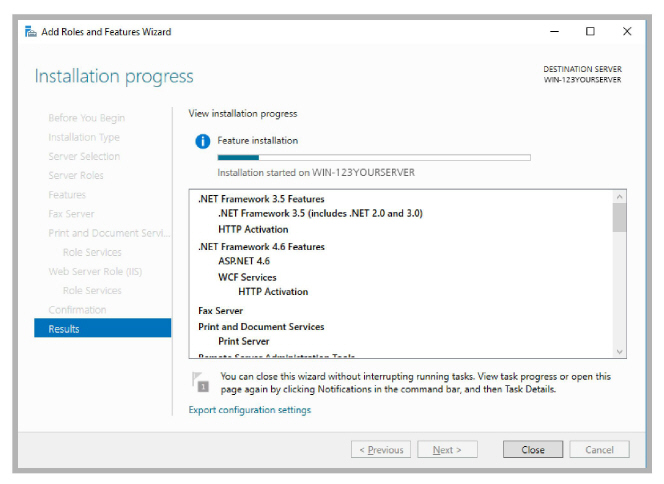
|
Note: This window can be closed without interrupting the installation procedure |
18.Once all changes are complete, Restart the server.
Disabling User Account Control Notification
1.Open the Windows Control Panel and select User Accounts.
Again, click User Accounts.
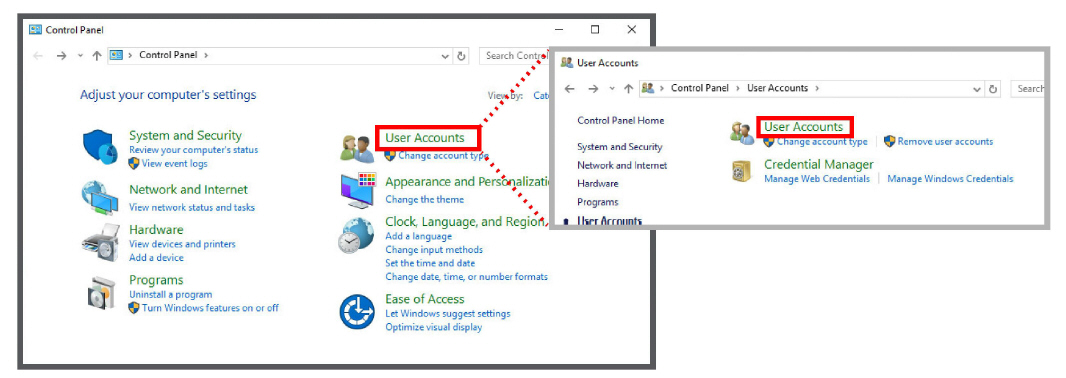
2.Select Change User Account Control settings.
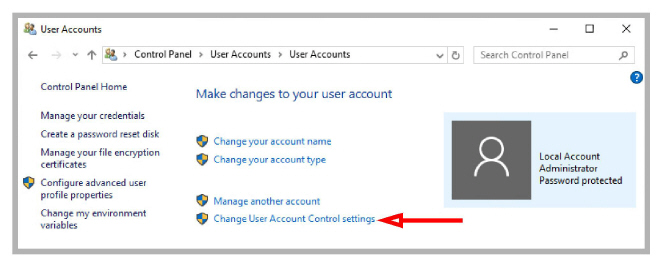
3.Click and drag the slider down to Never Notify.
Click OK and Close.
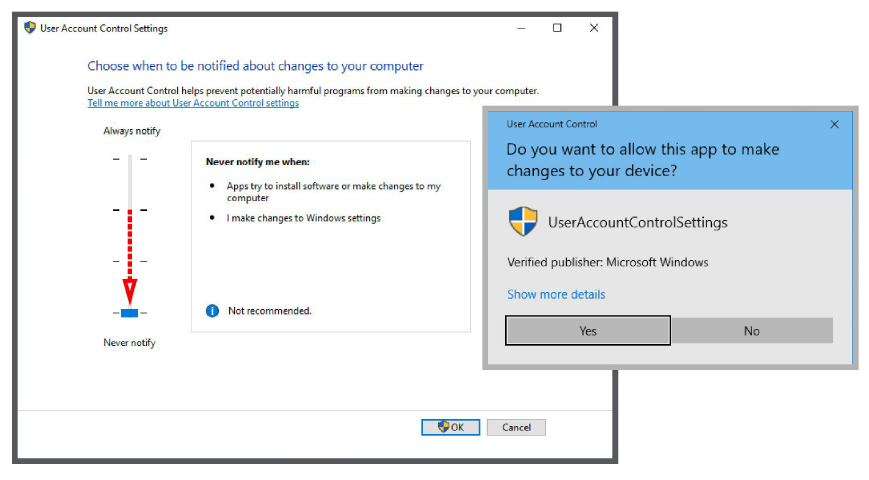
4.Open the Start menu and select Windows Administrative Tools.
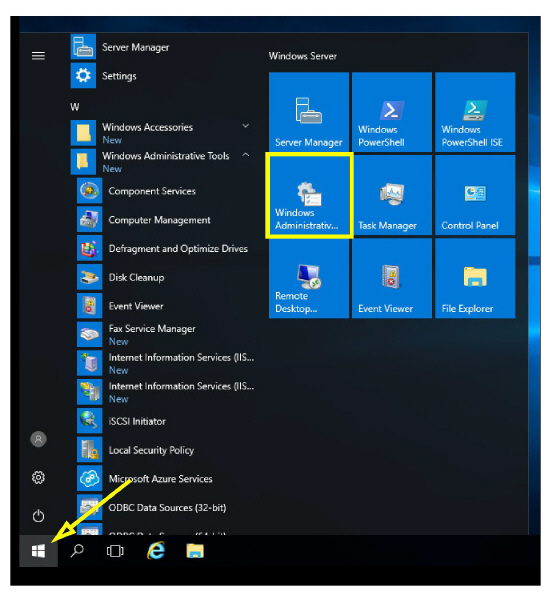
5.Double-click Local Security Policy.

6.Under Security Settings > Local Policies > Security Options, double-click
User Account Control: Run all administrators in Admin Approval Mode.
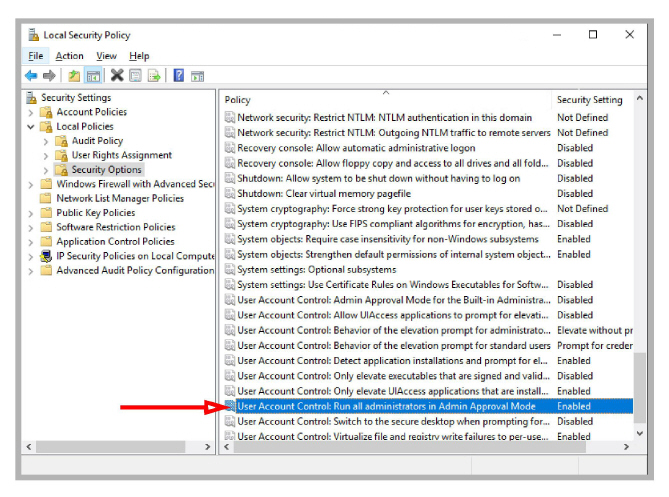
7.Select Disabled. Click OK.
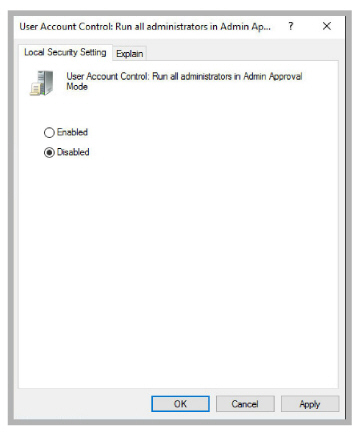
8.Restart the computer to make the changes active.
|
Note: UAC Notifications can be restored after Avaya Messaging has been installed. |
The site administrator must install either a self-signed certificate, or a certificate purchased from a Certification Authority.
It is not necessary to install both types of certificate.
|
Note: Corporate security protocols may require the use of certificates purchased from an appropriate authority. High-security (JITC) installations always require a CA issued certificate for the Encrypted File System (EFS). |
Additional information on installing certificates onto the voice server can be found here:
https://technet.microsoft.com/en-ca/library/cc753127(v=ws.10).aspx
Once the certificates have been installed, continue with IIS Certificate Bindings.
To enable an HTTPS connection, a certificate has to be installed on the voice server.
The HTTPS protocol must be enabled, and HTTP disabled.
1.On the computer that functions as the web server, open the IIS Manager console.
Select the local computer. Open Server Certificates in the right-hand pane.
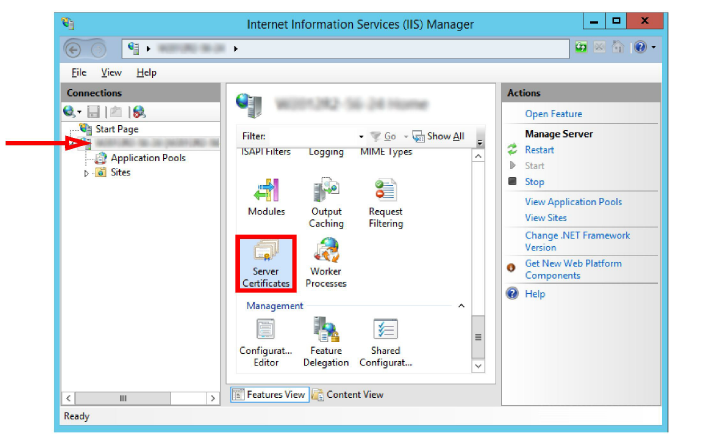
2.Right-click in the right-hand pane and choose Import from the pop-up menu.
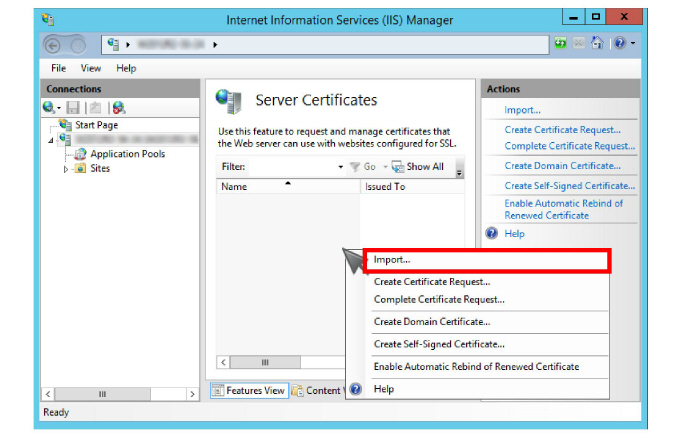
3.Enter the path to the certificate file and the password. Select Personal as the Certificate Store. Click OK.
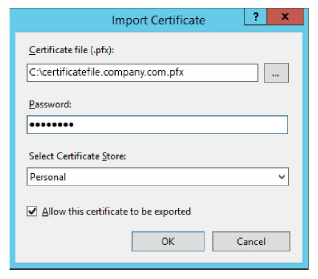
4.Go to Sites > Default Web Site.
Click Bindings....

5.Add the HTTPS binding type.
Set the IP Address to All Unassigned. Leave Port at its default.
Change SSL Certificate to the certificate name installed above.
Click OK.
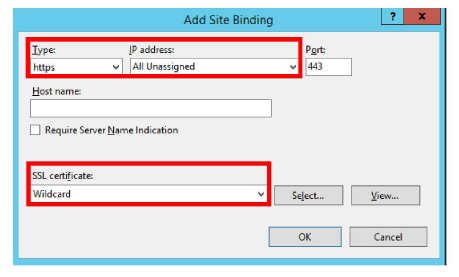
6.Remove HTTP from the list of bindings.
Click Close.
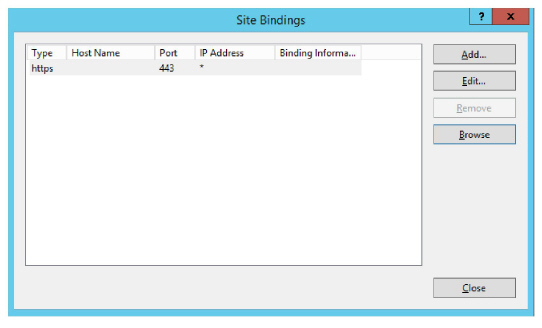
Install Microsoft .Net Framework 4.8+
Avaya Messaging requires Microsoft .Net Framework version 4.8 or later to be installed to support various features within the program. If it has not already been installed, the administrator must download it and install it manually.
|
Note: .Net Framework 4.8+ is not installed by default. It may be part of Windows updates, optional updates, or not provided at all. Follow these instruction is it is not installed on your system, or if you do not know if it has been installed. |
1.Open a web browser and go to the Microsoft web site. Search for the latest version .Net Framework and install the application on the server.
2.Download the file to your server drive. When ready, run the program to install this feature.
3.When finished, restart the server.
|
Note: Make sure that all of the necessary Services for your operating system have been installed before proceeding with the installation. Refer to the appropriate section of the Server Installation Guide for details. Also make sure that Windows Firewall is disabled, and that Windows Automatic Update is turned off. |
These rules are applied to all passwords created or used with Avaya Messaging, including those created during installation (Note: JITC installations have more stringent requirements). These include:
•Length: Passwords must be at least 14 characters long.
•Class: A password can contain upper and lower case characters, numbers and special characters. No minimum requirements for each character class are set by default, but this can be configured by the administrator.
•Repeating Characters: No character can be repeated more than 2 times consecutively (hello, Wrong!!). This value can be modified by the administrator.
•Repeating a Character Class: No class of character can be repeated more than 4 times consecutively (ABCD, !@#$). This value can be modified by the administrator.
•Reusing Passwords: No new password can be the same as a previous password extending back 10 iterations. This value can be modified by the administrator.
•Sharing Passwords: Passwords must not be shared between users. Only one login per account is allowed at one time. Other users must login using different credentials.
|
Note: It is strongly recommended on all fresh installations to logon to Windows with a Service Account with Full Administrative privileges to run the setup.exe. |
|
Note: Using an administrator account to perform routine functions leaves the servers open to malicious software attacks. Therefore, it is strongly recommended that each user with administrative privileges is also assigned a standard user account. To maintain security integrity, the administrator account should only be used when necessary, and should be immediately logged out afterwards. |
1.
|
Note: If the user who will be installing Avaya Messaging has not logged in as the system administrator, that user must be given full rights to the root of the C drive. |
Download the installation file (see chapter 4). Run the file (double-click) to extract the contents. Specify the location on your hard drive where you want to save the files.
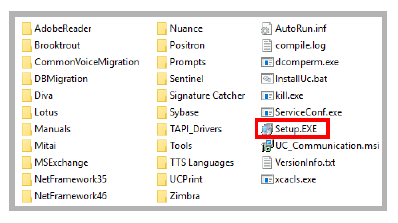
2.In the extraction folder, run Setup.exe as administrator to install Avaya Messaging onto your voice server.
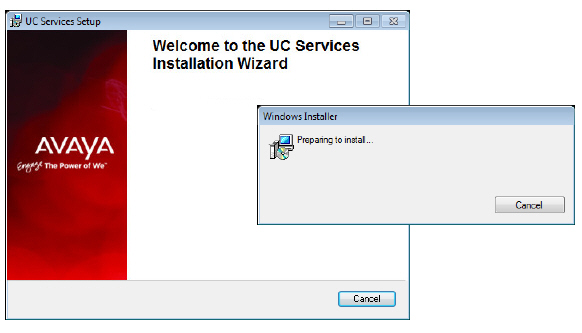
3.Once the Windows components have been verified, click Next to begin the installation.
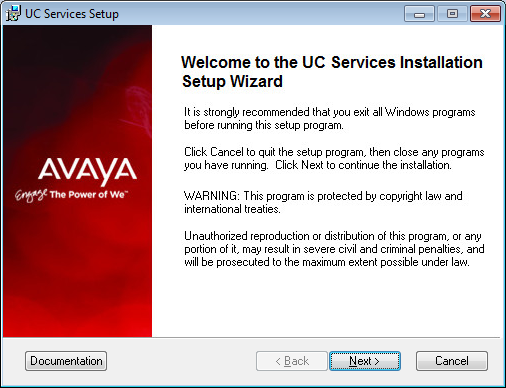
|
Note: The installer will automatically add the necessary packages if they do not already exist on the system. These packages may include Sentinel Protection, and Microsoft Visual C++ Redistributable. This process may take a while depending on the missing components. |
|
Note: Clicking on the Documentation button will provide you with the default set of PDF documents which comprehensively cover most aspects of Avaya Messaging. They can also be accessed from resources.avayacloud.com in both PDF and HTML format. |
4.Enter the DCOM settings (local machine administrator login information). This is required by services which use local administrator rights.
Click OK after entering the credentials.
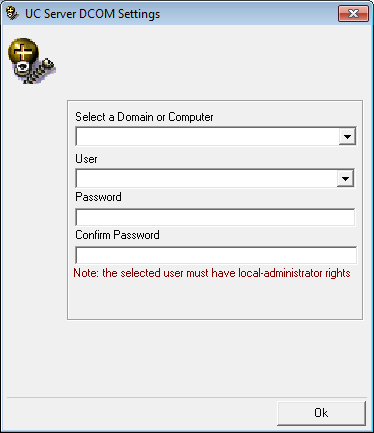
5.Review the license agreements and enable
I accept the license agreement.
Click Next to continue.
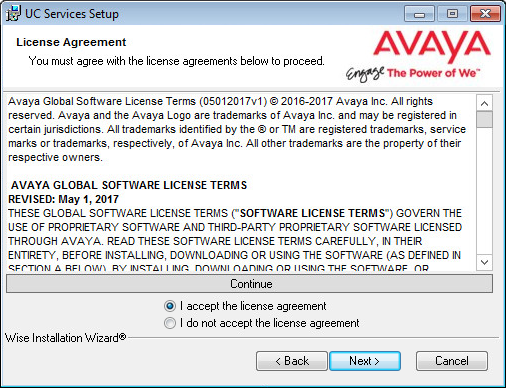
6.You will be asked to select the destination of the installation. You may change the hard drive destination through the drop down menu. By default, the installation will create a UC folder on the C drive.
Click Next to continue.
|
Note: It is highly recommended that you install the program to a drive other than C to prevent any conflicts or performance issues. |
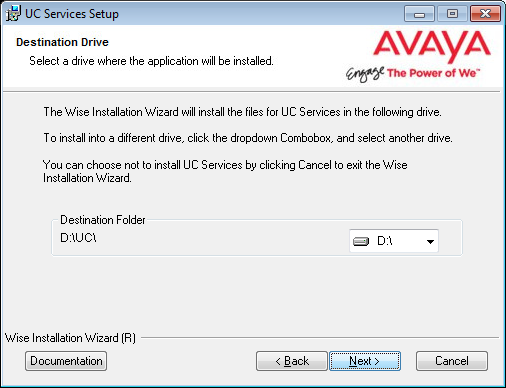
7.Enable Single UC Server.
Click Next.
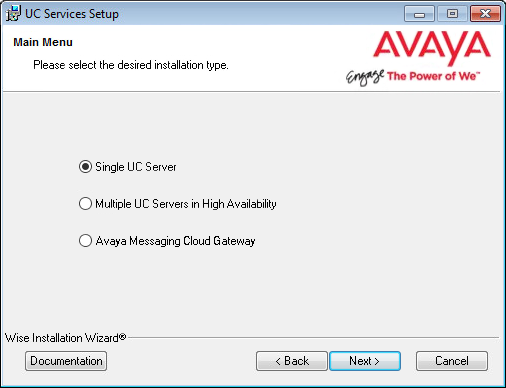
Single UC Server: When operating Avaya Messaging on a single voice server computer.
Multiple UC Servers in High Availability: When running Avaya Messaging in High Availability mode for redundancy.
Avaya Messaging Cloud Gateway: Gateway allows end-to-end synchronization between the Avaya Aura Messaging server and Google's Gmail using Avaya Messaging message sync and the CSE.
8.Select the license type you will using for this installation.
Most sites will use the Avaya WebLM License option.
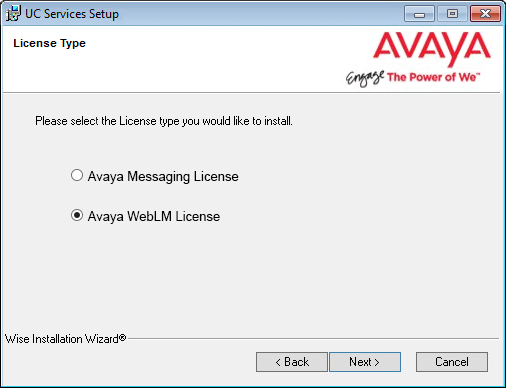
|
Note: If you select Avaya Messaging, go to chapter 13, Installing the Avaya Messaging License. When finished, return here and continue the installation from step 11. Skip step 9 through 10. |
|
Warning: It is essential that the system/PC clock be properly set before activating the license. Any subsequent changes to the clock can adversely affect or terminate the license. |
9.The License Upgrade Utility program opens and prompts you to enter the IP Address for the computer that houses the WebLM license engine.
Enter the address in the space provided, then click OK.
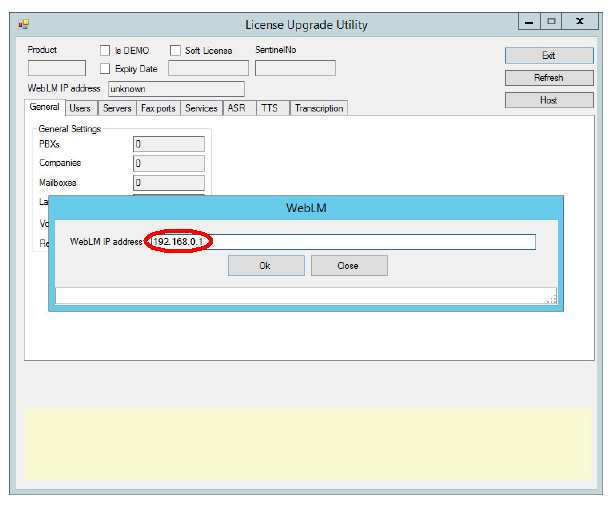
|
Important: This step requires that the Web License Manager has been installed and configured on the license server computer. See Installing the WebLM License and Server on page 535. |
10.The utility will retrieve your license details from the server and display them here. Review the license details and click Exit when ready.

11.Select the Components required at your site.
Click Next.
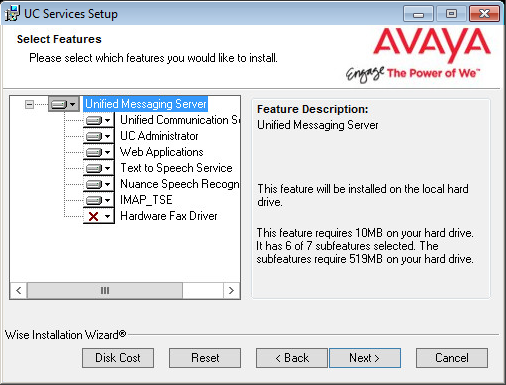
|
Note: If the Dialogic SR140 fax software will be used with this installation, ensure that the Hardware Fax Driver option is enabled here. |
12.This screen shows all of the Windows roles and features that Avaya Messaging requires to operate properly.
|
Note: This screen will only appear if one or more required components are not installed on the computer. |
For all items that are not checked, return to Windows and add any missing pieces to the operating system.
Click Next when finished or to refresh the display.
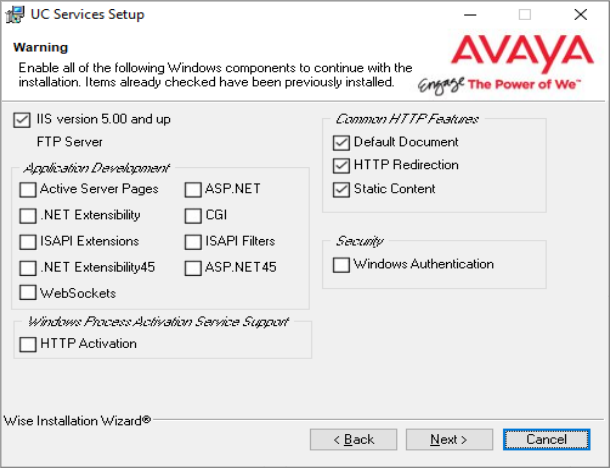
|
Note: The installation will not continue until all of the required components have been added to Windows. |
13.This screen shows the IIS settings that Avaya Messaging requires to operate.
|
Note: This screen will only appear if one or more of the required settings has not been made on the computer. |
For all items that are not checked, return to the IIS Manager in Windows and set these options as required.
Click Next when finished or to refresh the display.
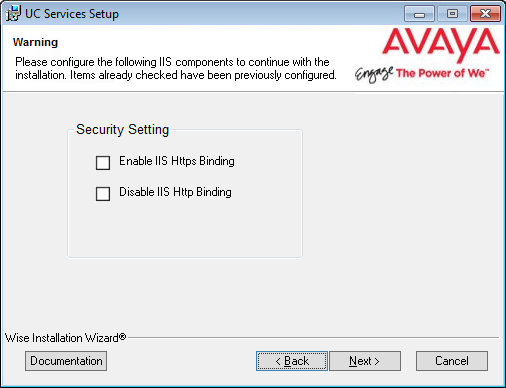
|
Note: The installation will not continue until all of the required IIS settings have been made. |
14.Select your PBX Brand then click Next.
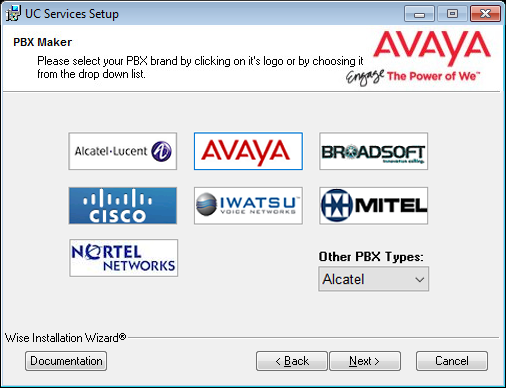
15.Select your PBX model from the dropdown menu.
Click Next.
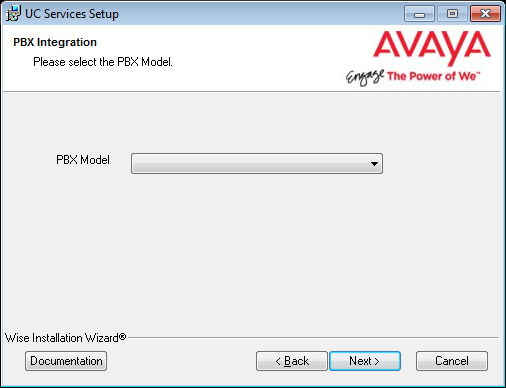
16.Select the Email Server Type from the list of available options. This allows the system to set basic parameters which help to improve performance and reliability.
When ready, click Next.
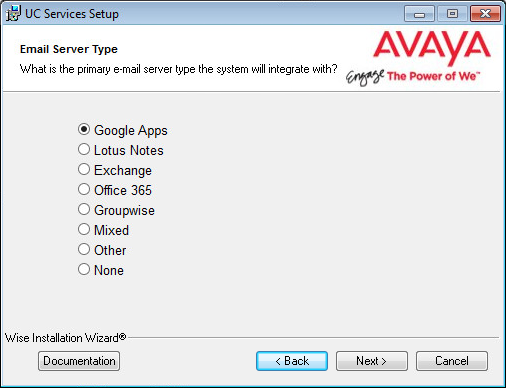
17.Enter the primary location from which most telephone calls will be placed. This will normally be where the corporate office is situated. Additional dialing locations and rules may be defined after the installation is complete.
Select the country from the dropdown menu, and enter the area code in the space provided.
Click Next to continue.
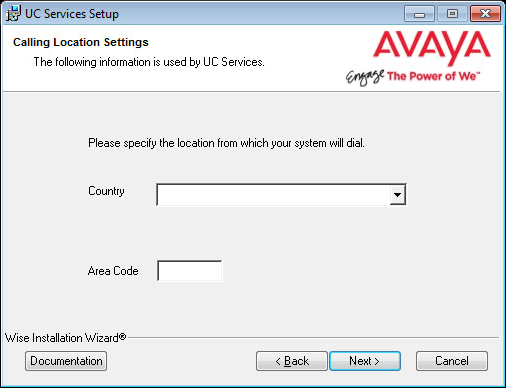
|
Note: If the Phone and Modem Settings under Windows Control Panel have already been configured, this step will not appear. The values entered there will be used automatically. |
18.Create and verify a UC IIS User Password. This is used when logging into any associated web applications, such as Web Access.
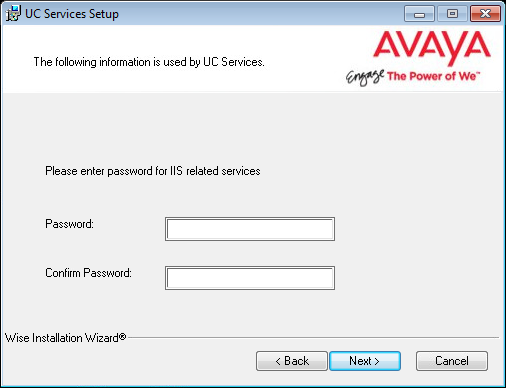
19.Enter a password to provide administrator only access to the system. This account password is used to configure the many elements of Avaya Messaging.
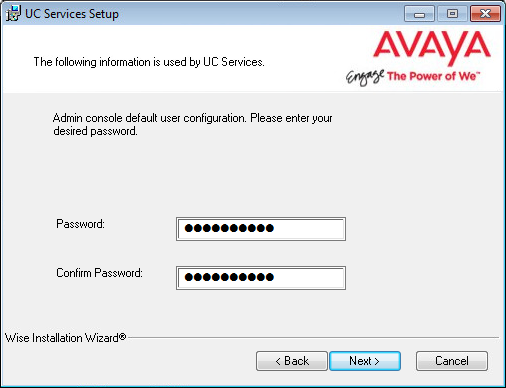
20.Choose either Yes or No to determine whether the system will apply General Data Protection Regulation (GDPR) compliance procedures to your data.
With this option enabled, users and callers are notified that personal information will be collected. This information can also be completely removed from the system upon request.
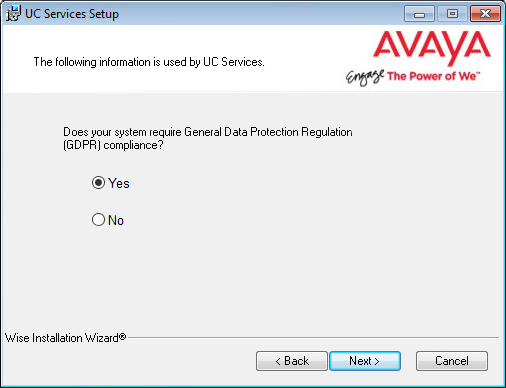
21.The preliminary information required for installation is now complete.
Click Next.
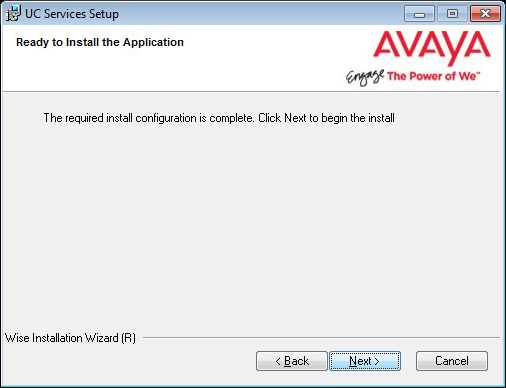
22.The selected components will now be installed. This process may take a while.
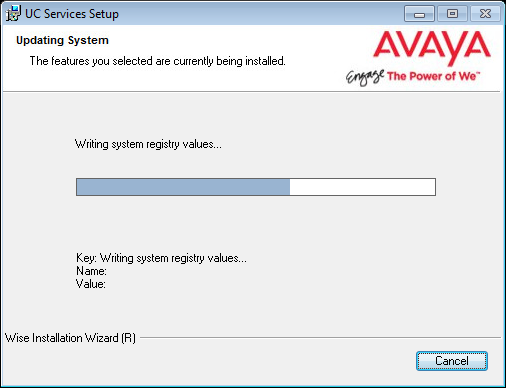
23.If you are warned about components being in use, either use the Automatic Close option or manually close the process which is interfering with the installation.
Click OK when ready.
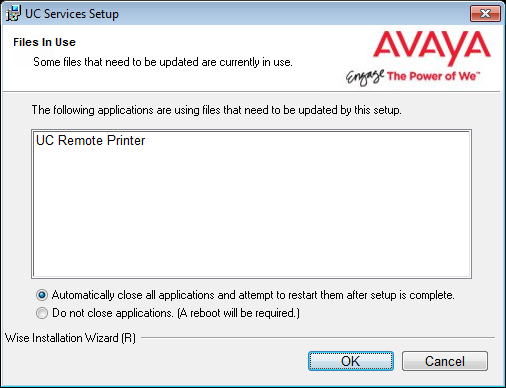
24.After all the components are copied, you may be asked to provide the settings for the PBX that you have chosen. Since this process varies greatly from system to system, please ensure that you configure your site’s PBX exactly as required.
25.Provide any additional settings for SIP integration for your site.
Click Next to continue.
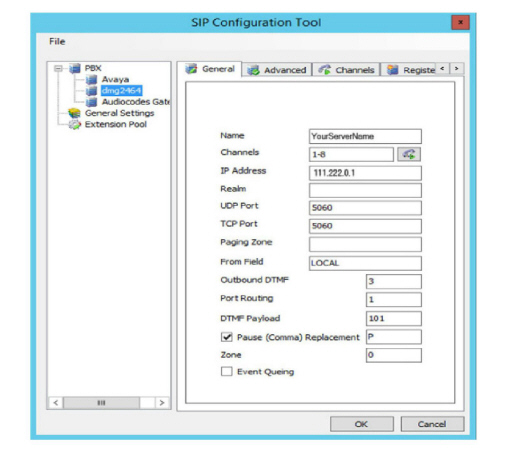
26.After all the components are copied, you may be asked to provide the settings for the PBX that you have chosen. Since this process varies greatly from system to system, please ensure that you configure your site’s PBX as required.
27.At the OAI Configuration Wizard screen:
•Enable Direct TCP/IP.
•Set Number of Nodes = 1.
•Activate the Enable logs radio button. The default path for the log files is shown. Enter a different path if the log file will be saved to another location.
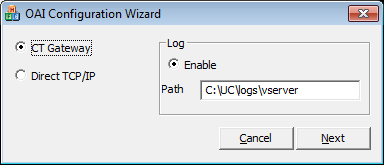
Click Next.
28.On the Link Information page, enter the IP Address of the PBX.
Leave Port at its default setting (4000). Leave the Login Password field blank.
Click Next.

29.At the Dialog screen, from the lists on the left-hand side, choose the desired Stations (extensions and voicemail ports), Hunt Groups and Trunks to use with OAI.
Select an item on the left, then click Add to move it into the right-hand pane.
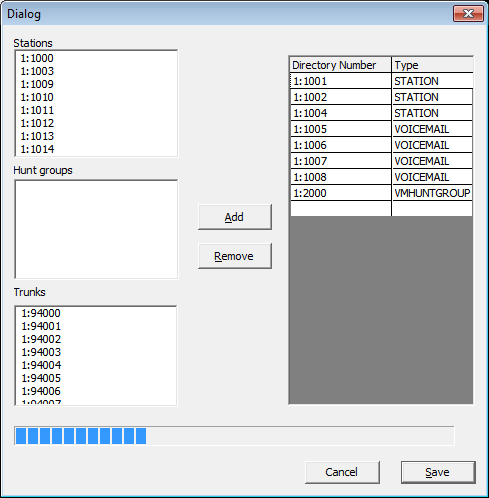
30.Click Save to finish the OAI setup and continue with the Avaya Messaging installation.
31.The Avaya Server Wizard can be closed without configuration unless integrating with AES.
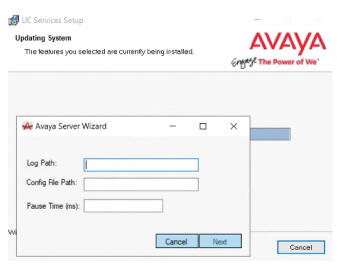
32.On the SSO Configuration screen, enable Legacy SSO. From the dropdown menu, enable the Providers that you want your clients to be able to use to access Web Admin, Avaya Messaging Admin, Web Access, and Web Reports. Items that are disabled will not appear during client login.
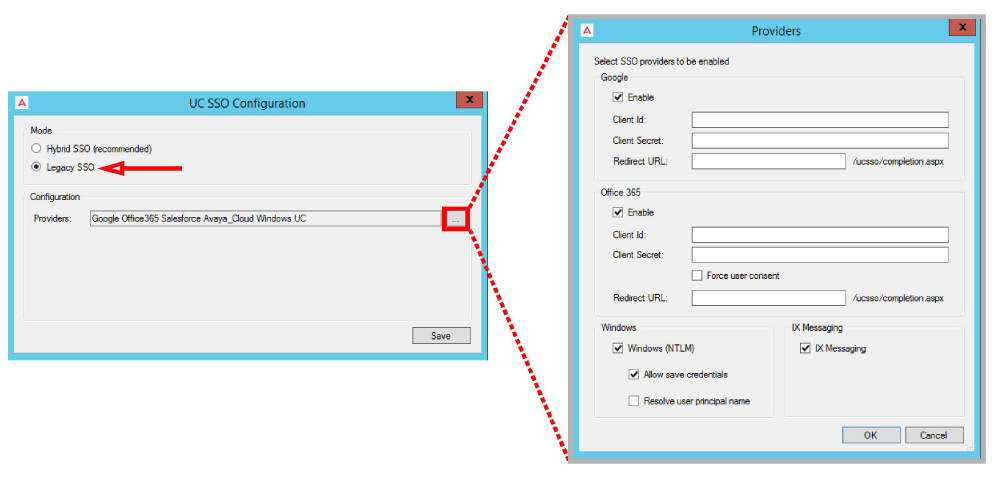
When clients / admins want access to these programs, they login using their credentials for one of the listed programs. They must have an account with that application before they can login.
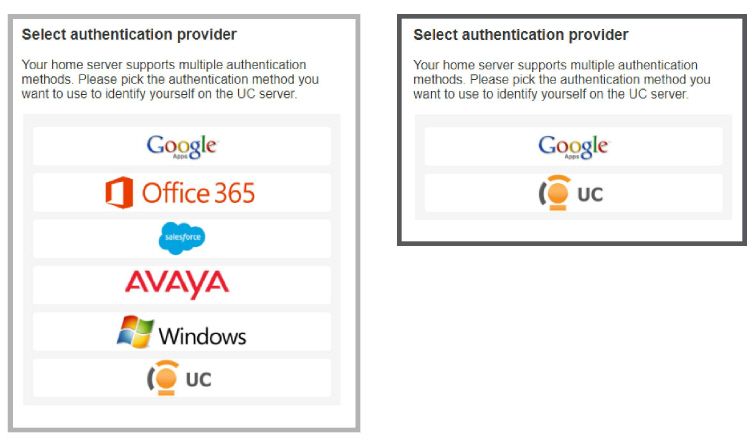
Enable all that apply, then click OK.
Click Save when finished.
|
Note: For complete details on using legacy and hybrid SSO, refer to chapter 26 of this document. |
33.Click Finish to restart the server.
If you wish to restart your computer at a later time, disable the Restart check box then click Finish.
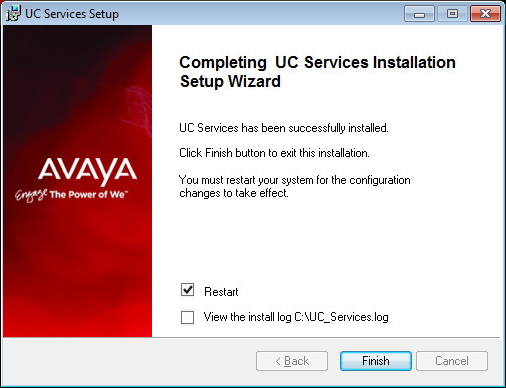
The Avaya Messaging installation is complete.